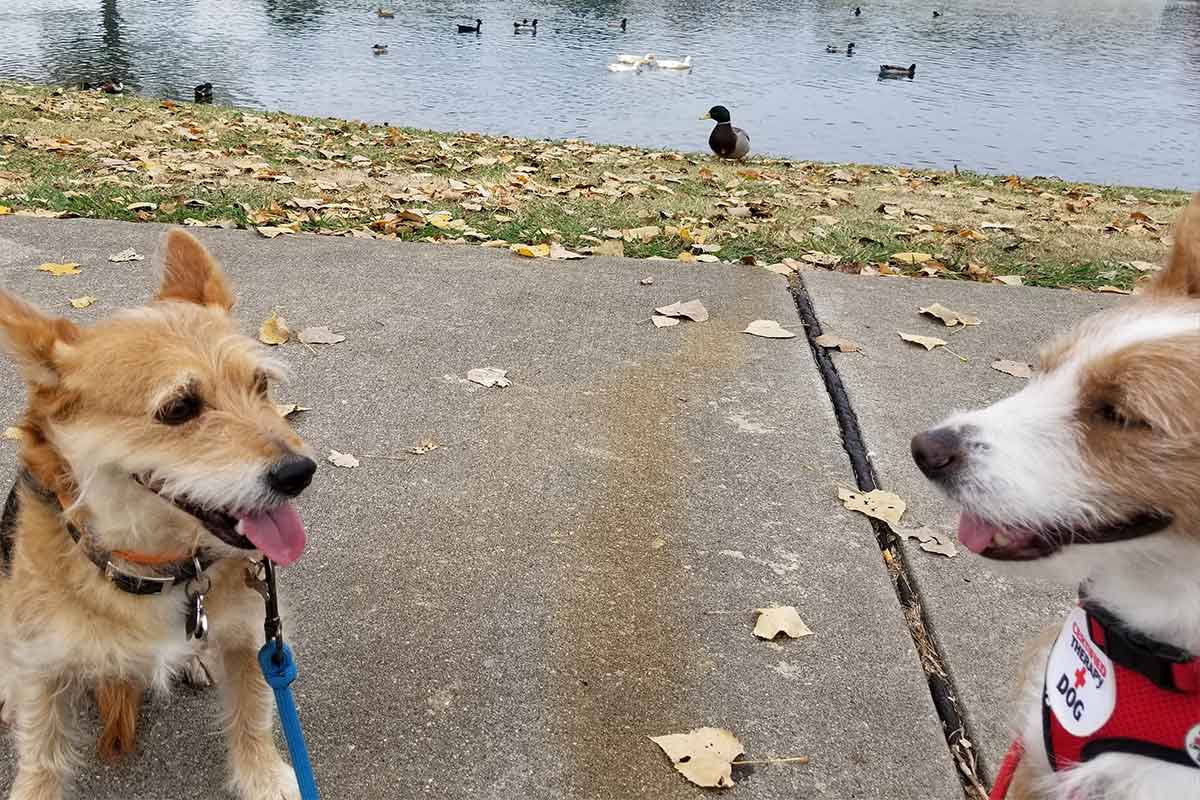Ask yourself: Do you like all people all of the time? Probably not – and that’s perfectly acceptable. And the same applies to your dog.
“For 95 to 98 percent of dogs, the simple answer is yes, they like having doggy buddies,” says Nicholas Dodman, BVMS, professor emeritus at Cummings School of Veterinary Medicine at Tufts University and a board-certified veterinary behaviorist. “But not every dog wants a doggy buddy and that’s okay.”
So don’t be critical of your dog if he dashes behind you to avoid uninvited meet-and-greets with other dogs on leashed walks. Or if he shakes or hides in a corner during another dog’s birthday party or does his best to ignore other dogs at the local dog park.
Credit – or blame – his experiences as a young pup. Veterinary behaviorists identify the first three months of a dog’s life as a sensitive socialization period. How a young pup acts and reacts in social settings during his first 12 weeks of life shapes his responses for the rest of his life.
“Learning does not stop after 12 weeks, but this is the period when a dog’s view of dogs is formed,” explains Dr. Dodman, chief scientific officer at the Center for Canine Behavior Studies in Salisbury, Connecticut. “Dogs who have had exposure to lots of dogs in the right way at this age tend to be more socialized than those who did not.”
Lisa Radosta, DVM, a board-certified veterinary behaviorist with Florida Veterinary Behavior Service in West Palm Beach, advises people with dogs who don’t seek out other doggy buddies not to force furry friendships or to feel guilty about their dogs’ I-don’t-need-other-dogs attitude.
“It may seem weird to some, but some dogs are actually really happy not being social with other dogs,” says Dr. Radosta. “So many owners pass judgment on themselves because their dogs are not good candidates for doggy daycares or do not wish to play with other dogs in dog parks. The most important thing is that their dog is happy, and happiness is defined differently by individuals, including dogs.”
Forcing your dog to meet another dog can cause unwanted consequences. Your dog may display cold-shoulder indifference, heightened stress, elicit get-away-from-me growls or feel compelled to flee or fight the other dog.
Both Drs. Dodman and Radosta recommend you focus on your dog when another dog approaches. Look for telltale signs that indicate if your dog welcomes a sniff-and-greet or prefers to avoid a canine introduction.
A dog willing to meet another dog will do some or all of these actions:
* Exhibit a relaxed body posture.
* Avoid direct eye contact with the other dog.
* Plop into a play bow (his rear end raises in the air as he lowers his head and extends his front legs).
* Wag his tail gently and loosely.
A dog doing his best to reject meeting an approaching dog will do some or all of these actions:
* Start lip licking – a sign of anxiety.
* Tuck his tail – a sign of fear.
* Duck behind you to avoid the other dog.
* Emit low growls.
* Stiffen his body and make non-blinking stares at the other dog.
* Lunge on the leash when the other dog gets close due to feeling threatened.
“Dogs who are anxious about meeting other dogs will look nervous and feel uncertain,” says Dr. Dodman. “Anxiety is more of an anticipatory fear. Your dog is worried something may or may not happen. Dogs exhibiting anxiety will have increased heart rate and blood pressure. These dogs clearly do not wish to meet the other dogs.”
If your dog signals that he does not want to meet that bouncy dog on a leash heading your way, Dr. Radosta says to avoid intensifying the situation. Don’t unleash a series of loud no-no-no’s to your dog and tighten the grip on your leash. Instead, be proactive by abruptly turning and taking your dog in another direction away from the dog or be frank with the other person.
“I have no problem saying, ‘My dog bites – move your dog away from my dog’ or make an excuse to leave or do a friendly wave goodbye as the person and dog approach,” she says.
The key to preventing undue fear, stress, or aggression in your dog is to take the time to really know your dog and respect his comfort level in social settings.
“The primary obligation is the safety and well-being of your dog,” says Dr. Radosta. “Dogs are constantly downloading information, and your goal is for your dog to have more good experiences than bad ones.”
This article was reviewed/edited by board-certified veterinary behaviorist Dr. Kenneth Martin and/or veterinary technician specialist in behavior Debbie Martin, LVT.








